Klytia (post 1945)
Continued from: Klytia (1930-1945)
Information on the operations of the company after 1945 are very patchy but most indications show a downward trend. As well as the large number of preexisting French and European beauty businesses, Klytia also had to contend with new French and European entrants such as Orlane, Clarins and Juvena. Then there were the Americans. Well-established American firms such as Elizabeth Arden and Helena Rubinstein revived their French businesses after the war and were joined by new American companies such as Revlon. Compared to Klytia these were very large businesses with substantial budgets to spend on product development, advertising and distribution.
In the 1950s, Klytia tried to reestablish its businesses in the lucrative American market dispatching Antoine Font to the United States in 1956 to see if anyone was interested in manufacturing Klytia products there under license. He did not find any suitable candidates. I also note that although Klytia registered its business in Canada in 1947 this also does not seem to have produced results.
Products
After 1945, Klytia began manufacturing some products that had been discontinued during the war such as Crème Léntive au Suc de Laitue No. 117 and introduced a few new lines such as: Sève Nutritive No. 7, a type of skin food; Superdémaquillant No. 42, a creamy cleanser; and Crème Aurore No. 132, a powder base.
Bonheur du Jour
Klytia’s first major promotion after the war was its ‘Bonheur du Jour’ range. This appears to have started in 1949 with the introduction of a new perfume, Parfum Bon Vieux Temps, sometimes referred to as Parfum Bon Vieux Temps 1900. Klytia sold a Poudre de Riz le Bon Vieux Temps No. 38 in the 1920s, packaged in a plain white satin box with a bow, but I have been unable to find any trace of them selling a perfume by that name until 1949.
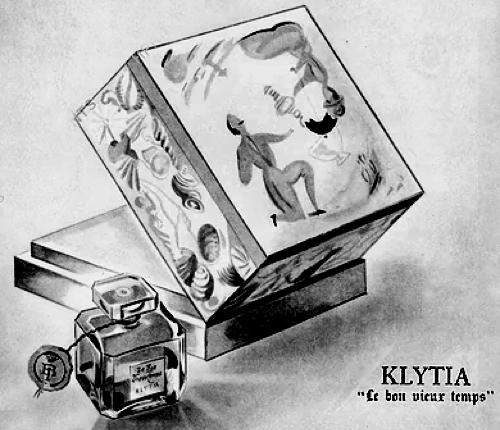
Above: 1949 Parfum Bon Vieux Temps and powder No. 38.
Advertisements for Parfum Bon Vieux Temps depict it in a small glass bottle next to a powder box embellished with images reminiscent of the year 1900. Klytia advertised that they were selling Poudre Bon Vieux Temps in fifteen shades in 1950 but all the images I have seen of this powder box have it labeled as Bonheur du Jour not Bon Vieux Temps, even though has the same number as the powder from the 1920s. The perfume and the Bonheur du Jour powder formed the basis for the Bonheur du Jour range which debuted in 1950. It is possible that they simply changed the names of both the perfume and powder but that is speculation.
As well as the perfume and Poudre Bonheur du Jour No. 38, the series included Eau de Toilette No. 152, Lotion de Beauté No. 153, Lait Suractive No. 154, Vitaklytia No. 155, Vitaklytia No. 156 and Hormoklytia No. 157 with Tonic Bonheur du Jour made with an algae extract added in 1954.
Vitaklytia No 155 and No. 156: A day cream to beautify the complexion and act as a powder base.
Hormoklytia No. 157: Deeply revitalises the epidermis overnight.
Lait Suractive No. 154: Removes makeup, dissolves and removes all impurities.
Lotion de Beauté No. 15: For quick cleansing and for use as a powder base.
Poudre Bonheur du Jour No. 38: Light, adherent, with expressive shades, with a fresh scent. Known shades: Naturelle, Naturelle Ambrée, Pèche, Rachel, Abricot, Mauresque, and Ocre des Iles.
Eau de Toilette No. 152: Refreshing, essential.
Parfum: Young, refined, penetrating, suitable for all hours of the day.
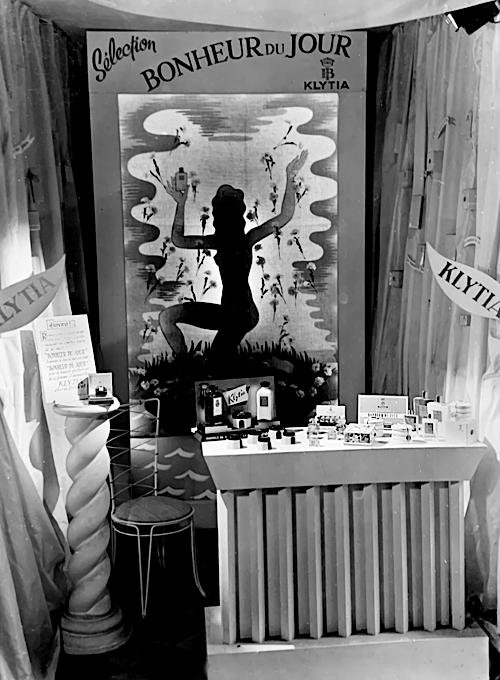
Above: c.1950 Bonheur du Jour display stand at a trade show.
Biologicals
Vitaklytia and Hormokytia were the first in a series of skin-care cosmetics introduced by Klytia in the 1950s and 1960s that featured ‘biological’ ingredients. Vitamins and hormones had been used in cosmetics in the 1930s but these were joined by a wide range other ‘biologicals’ after the war, such as embryo extracts, royal jelly, and placental extracts, that claimed to have wonderful restorative powers.
Apart from vitamins and hormones, most of these ‘biologicals’ were championed by French companies backed by dubious by French research. Klytia was not the first to incorporate any of them into cosmetics and was largely in a position of playing catch-up with other French beauty businesses such as Orlane, Germaine Monteil, D. G. Payot, and Stendahl. The one exception to this was Tonic Bonheur de Jour which contained marine algae extracts. Klytia was an early adopter of marine algae having used them previously in Gelée Savonneuse Dépredditrice No. 68, one of its weight loss preparations.
Vitaklytia and Hormokytia were to be used together, Hormoklytia as a night cream and Vitaklytia as a day cream, No. 155 if the skin was oily, No. 156 if it was dry. There is some evidence that at least Vitaklytia came in a range of shades so functioned as a tinted foundation. All three products came in the same distinct bottle.
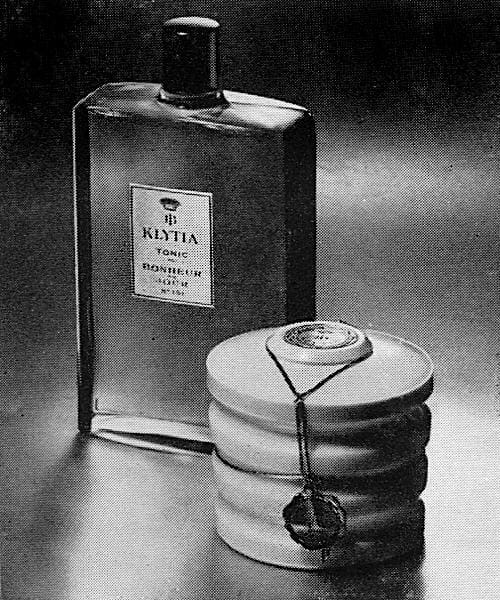
Above: 1956 Tonic Bonheur de Jour and Hormoklytia.
Unfortunately, I have no information on the vitamins or hormones used in these cosmetics. Vitaklytia may not have been the only products Klytia sold that contained vitamins. The pre-war Lait aux Roses de Jéricho No. 344 was also advertised as containing vitamins in the 1950s although I have no evidence that this was the case before the war.
See also: Vitamin Creams, and Hormone Creams, Oils and Serums
Another ‘biological’ skin-care cosmetics added by Klytia the 1950s was Embryoklytia (1951) made with chicken embryos. I have not seen an image of the container but it would not surprise me if it was house in something similar to that used for the vitamin and hormone creams.
See also: Embryo Extracts
In the 1960s Klytia continued with ‘biologicals’ adding mink oil to a number of cosmetics – Huile au Vision, Crème de Vision, Emulsion-Base, and Vision Fluid.
Huile au Vision: Applied on cleansed skin. Sinks in and nourishes the skin
Crème de Vision: An anti-wrinkle cream particularly suited to delicate skin.
Emulsion-Base: Applied under foundation to nourish and tone the skin and help secure make-up
Vision Fluid: An oil-based foundation.
See also: Mink Oil
Klytia introduced a similar series of cosmetics featuring collagen in the 1970s – Crème au Collagène, Lait au Collagène, Base de Maqullage au Collagène, and Fond de Teint au Collagène.
Moisturisers
Moisturisers were an important development in the late 1950s and 1960s. In 1955, Klytia introduced Top Cream which was described as hydrating. However, like other cosmetic companies at the time dry skin was considered to be due to a lack of oil not water. Top Cream was a night cream not a day cream and featured organic ingredients, presumably oils, considered to be its most important hydrating elements. This is not to say it would not have acted as a moisturiser but rather that its hydrating claim was not in the sense that we think of today.
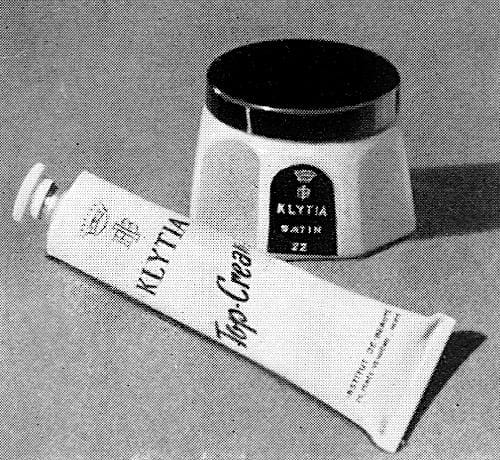
Above: 1956 Top Cream and Klytia Satin No. 22.
Like most other cosmetic companies, Klytia did introduce a moisturiser in the modern sense in the 1960s – Crème K8. This anti-wrinkle cream contained an NMF (Natural Moisturising Factor) to help protect the skin from dehydration and could be used at night or under make-up during the day.
See also: Moisturisers
Make-up
Apart from the previously mention Vitaklytia only new make-up cosmetics introduced by Klytia after the war, that I know, of were Milk Film, a liquid foundation in Abricot, Rachel-Soleil, Ocre des Iles, and Miami shades, and Pastel Mat, a compressed powder in an unknown number of shades.
I have the feeling that Klytia largely gave up on make-up after the war, perhaps deciding that keeping up with the changing face of fashion was simply not worth the effort. This is not to say that the company did not continue to sell make-up to those clients that asked for it but rather that there was very little product development or the introduction of new shades.
Later developments
As the decades progressed Klytia got deeper into trouble. Like other old established brands it had difficulty in attracting new, younger clients and, as its regulars died off its client base got smaller and smaller. Exactly when it closed I do not know but it was still operating in the late 1970s.

Above: 1962 Crème Juvénil and Tonic Juvélin hoping to attract younger clients. As far as I can tell Klytia did not try something similar with make-up.
Early in 2000, Thierry Marcadet [b.1956], a grandson of Marie Valentin Lebrun, decided to resurrect the company and formed a new business in 2003 based at 10 Place Vendême, Paris. It produced a new range of skin-care products under the Klytia brand based on biorhythms and marketed as chronobiology.
The business appears to have been bought by Nano Beauty in 2017 who subsequently changed their name to Klytia Paris in 2020. It still operates to day selling a range of skin-care cosmetics.
Timeline
| 1949 | New Products: Sève Nutriive No. 7; Supérdemaquillant No. 42; Crème Aurore No. 132; and Eau de Toilette No. 152. |
| 1950 | New Products: Vitaklytia No. 155; Vitaklytia No. 156; and Hormoklytia No. 157. |
| 1951 | New Products: Embryoklytia. |
| 1954 | New Products: Milk-Film; and Tonic Bonheur du Jour. |
| 2003 | Klytia S.A.S. established at 10 Place Vendême, Paris. |
| 2017 | Klytia acquired by Nano Beauty. |
First Posted: 18th January 2024
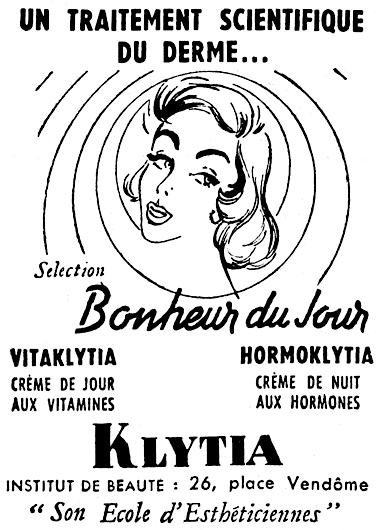
1952 Bonheur du Jour Vitaklytia and Hormoklytia.
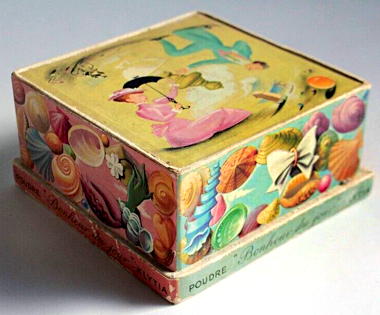
Poudre Bonheur du Jour No. 38.
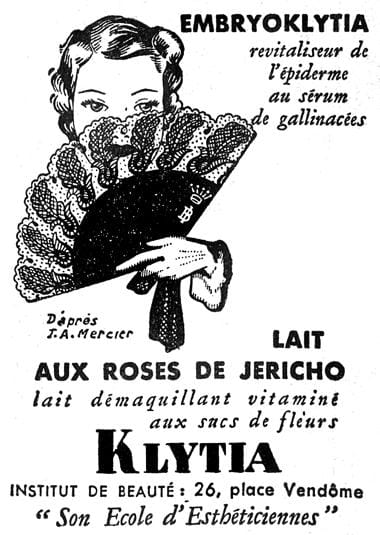
1952 Embryoklytia and Lait aux Roses de Jericho No. 344 using an illustration by Jean-Adrien Mercier [1899-1995].
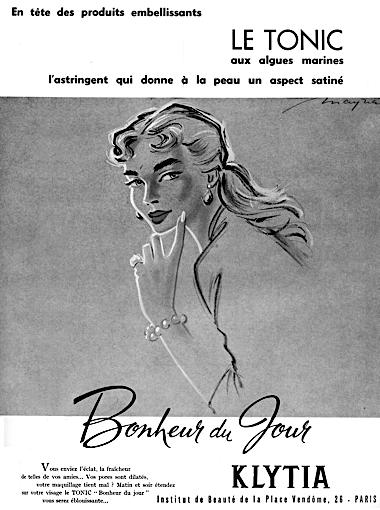
1954 Tonic Bonheur du Jour with marine algae.
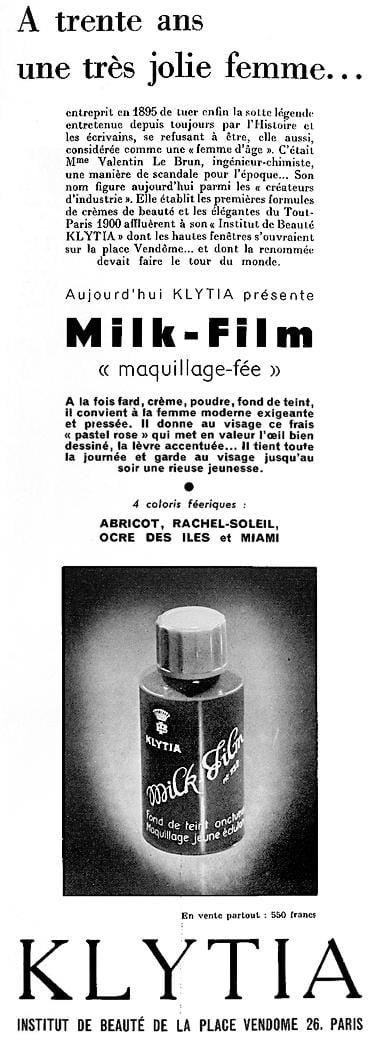
1954 Milk-Film.
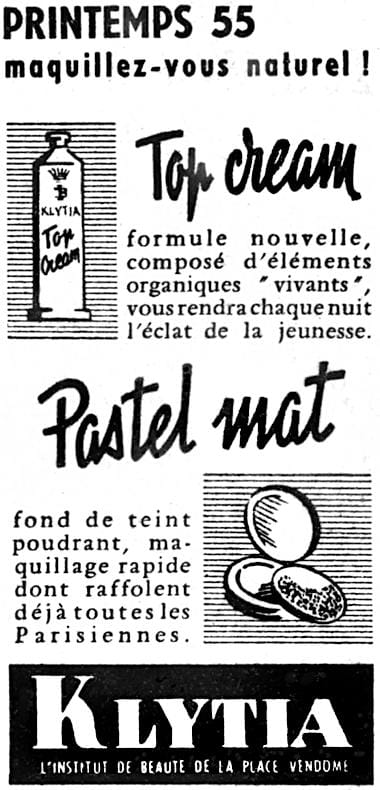
1955 Top Cream and Pastel Mat.
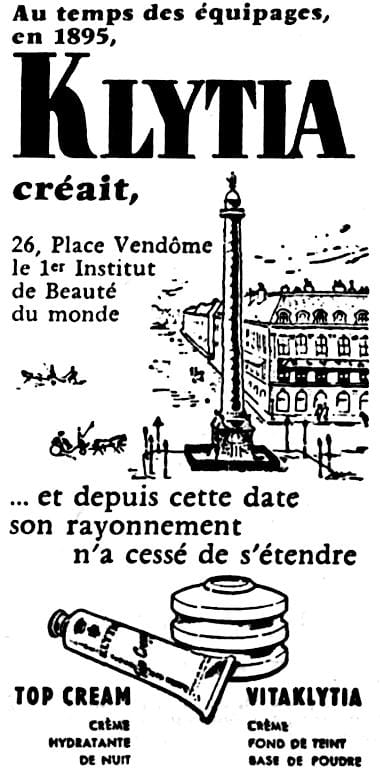
1955 Top Cream and Vitaklytia.
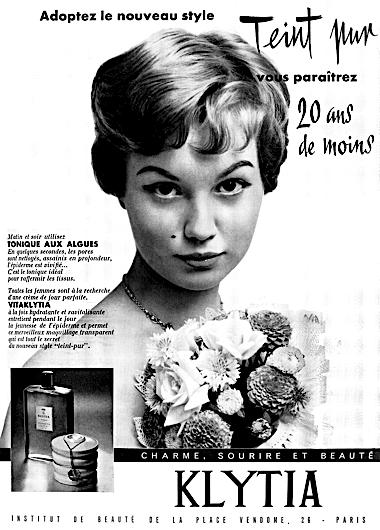
1956 Tonic Bonheur du Jour (Tonique aux Algues) and Vitaklytia No. 155 and 156.
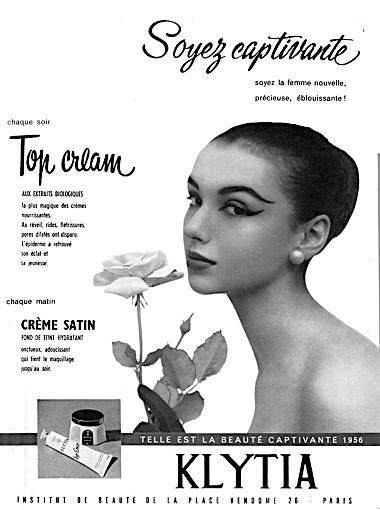
1956 Top Cream and Crème Satin.
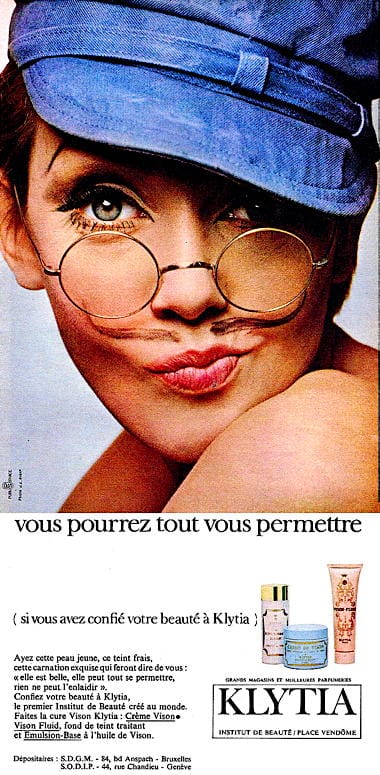
1966 Crème de Vision, Vision Fluid and Emulsion-Base.
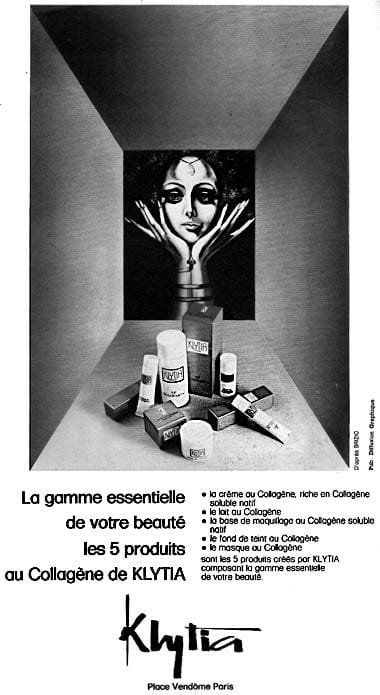
1978 Crème au Collagène, Lait au Collagène, Base de Maqullage au Collagène, and Fond de Teint au Collagène.
